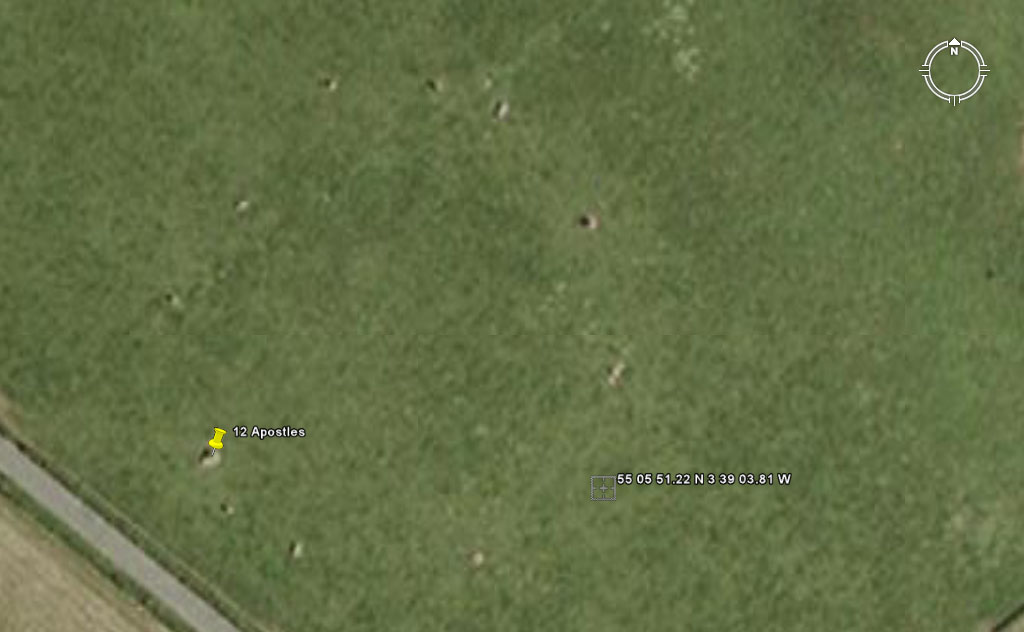
SO HOW DOES THIS ANCIENT NEW ZEALAND SURVEYING & NUMBER ENCODING PREOCCUPATION COMPARE WITH A TYPICAL BRITISH SITE?
The Twelve Apostles standing stone circle, Dumfries, Scotland.

The 11 large component obelisk-boulders that make up "The Twelve Apostles" standing stone circle can be easily detected in this Google Earth satellite photo. The largest obelisk or hubstone for the site is shown with a placemark on it. All secondary or outlying component stones relate back to the hubstone by way of coded distances and angles.
The precise position of the hubstone was determined by the crown positions of local high hills, predominantly to the West and a long range for observing solar rises to the East.
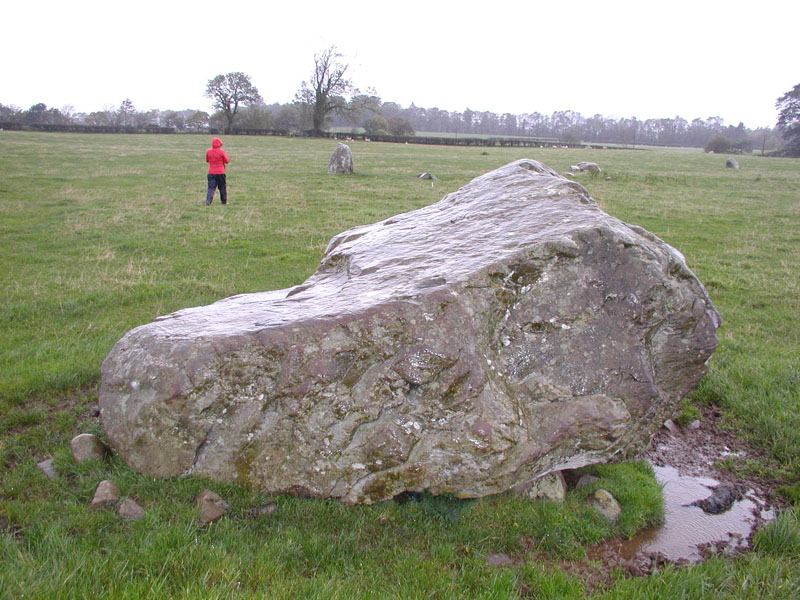
The giant hubstone of the 12-Apostles circle, recumbent with its pointed top lying towards the West. Photo courtesy of researcher, Bryan Mitchell, Cambridge, New Zealand.
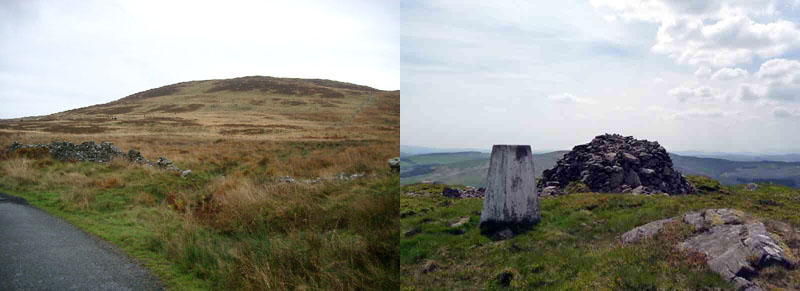
Six-miles due West of the hubstone at the 12-Apostles circle is Bishop Forest Hill, the highest hill in the region at 1286' (392 m). In the photo to the right the modern-day, concrete survey plinth (NX8479) atop Bishop Forest Hill can be seen standing adjacent to the ancient marker cairn.
For Megalithic-Neolithic Age astronomer-surveyors, setting up their alidade sighting rules at the 12-Apostles stone circle hub, a marked crown position of Bishop Forest Hill represented a perfect 270-degrees (true West). This high outer-marker hill should also have provided a perfect fix on the equinox, as the sun set on its southern side and disappeared into the hill.
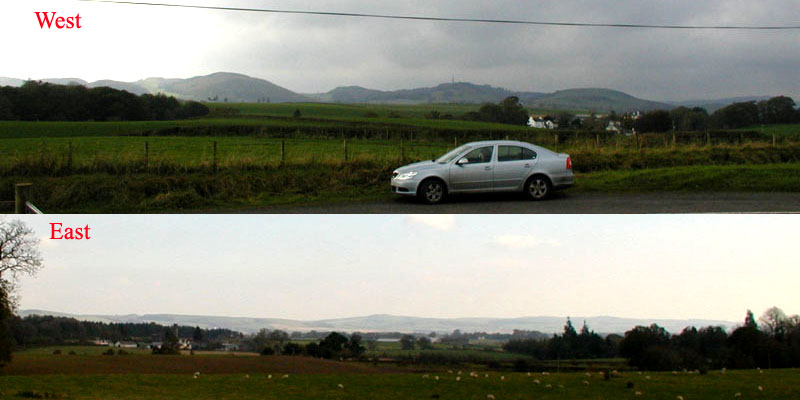
The standing stone circle is so situated as to provide dynamic views onto a series of hills to the West and a long range to the East.
To the East, the daily progress of the rising sun, as it moved from it's Summer solstice to equinox to Winter solstice positions along the Cumberland Range, would have provided ancient astronomer-surveyors with excellent calendar-fixes throughout the entire year.
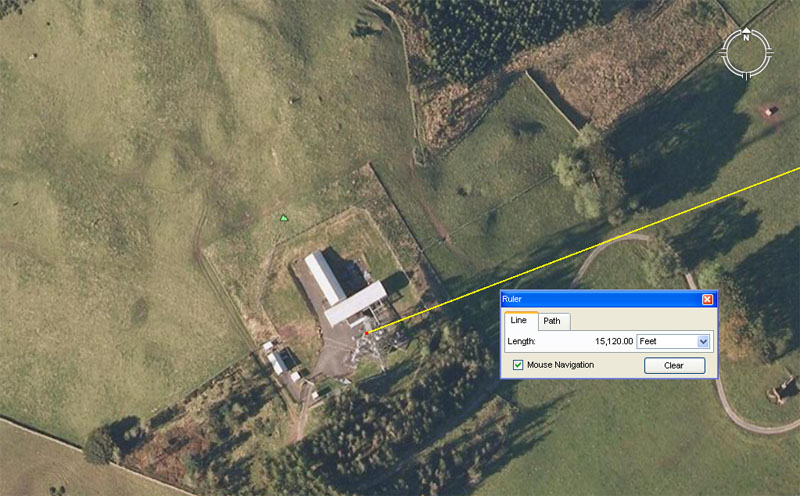
Another coded fix point for the 12-Apostles hubstone was the crown of See Morris Hill (also known as Riddings Hill ... 787.5' or 240 m high). A line of 15120' is seen to come in from the circle hubstone and resolve under the radio antenna on the hill. The return angle to the 12-Apostles hub is 69.12-degrees (693/25ths).
1. The distance of 15120' equated to 2.5-minutes of Earth equatorial arc under the ancient geodetic system of 12 X 12 X 12 X 12 X 1.2 = 24883.2 (so-called) Greek-miles of 5250' each (5000 Greek feet of 12.6"). This encoded distance of 15120' near Dumfries, Scotland, would also equate to 1440 Hebrew reeds or 14400 Greek feet.
2. In this much-used ancient navigational system that described the equatorial circumference as 24883.2-miles, the sum of 69.12 miles would be 1-degree of equatorial arc.
So-called Greek and Roman measurements or the "Sumerian" 360-degree angle system were positively marked into British landscapes of 3000 BC or earlier, over 2000-years or more before the Greek and later Roman civilisations emerged.
This careful placement of the 12-Apostles hubstone to achieve a perfect West marker on Bishop Forest Hill and Earth equatorial circumference codes on See Morris Hill duplicates what happened at Tahanga Hill hubstone, Opito, New Zealand, with its perfect easting onto Ohinau Island and use of the angle to Mount Manaia for dynamic coding of the equatorial circumference.
THE INBUILT CODES OF THE 12-APOSTLES STANDING STONE CIRCLE.
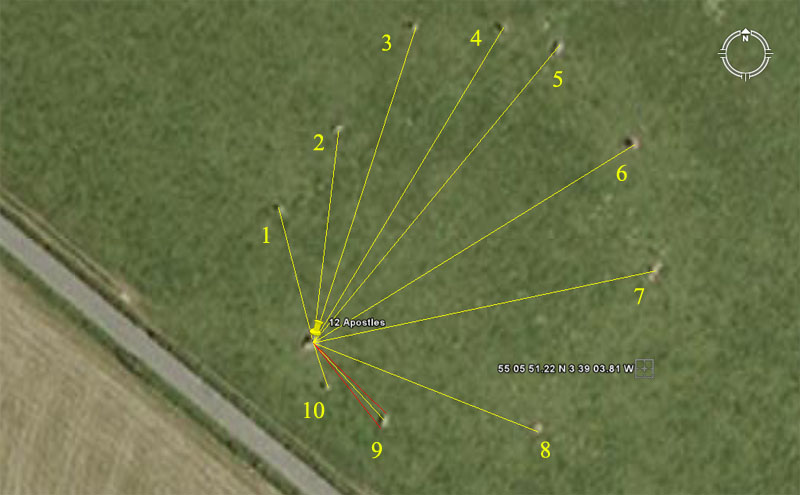
Although the 12-Apostles circle is, in terms of overall dimensions, a very expansive site (over 275' in diameter), it has few component stones.
The site would have functioned as an open-air-university for teaching initiates the sciences of navigation and cyclic astronomy, using the same parcel of special, factorable numbers shared between many cousin nations of antiquity - extending to the Mediterranean, North & South America and across the vast Pacific to ancient New Zealand.
It's important to realise that the stone positions represented mnemonic devices and it was essential that very adept tutors be present to identify the refined, factorable numbers encoded into each position, then clearly interpret what the numbers meant. By constant repetition and rote-learning, the students would memorise the precious sciences handed down to them by their forebears. The concept of civilisation and its preservation was based upon this hard-won knowledge and it was the duty of every generation to hand it on intact to the new generation.
Here are some of the apparent codes that would have been taught to students at the 12-Apostles stone circle from 2000 BC and possibly earlier:
1. 97.2' @ 345.6-degrees.
Traditionally, the 360-degree circle is divided up into both sixth and eight parts simultaneously, which accounts for divisions like 45, 22.5 or 11.25 degrees respectively. These divisions can be further sub-divided all the way to 1/256th and even smaller fractions, as required.
When considering the equatorial circumference of the Earth as the factorable value 24883.2-miles, a 1/256th division would be 97.2-miles (113/32nds degrees of arc).
Similarly, the outer circumference of the Sarsen Circle at Stonehenge was coded to be 345.6', based upon 30 horizontal lintel stones averaging 11.52' each. The mnemonic reference for the size of the Earth encoded into the outer rim of the Sarsen circle was 11.52-miles X 6 X 6 X 6 = 24883.2-miles. The sum of 6 X 11.52-miles = 1-degree of arc for the Earth under that navigational system.
2. 148.5' @ 6.804-degrees.
The distance of 148.5' was 1/40th of of an ancient Scottish mile of 5940'. The Scottish mile was 1 furlong (660') greater than the English mile of 5280' (which in turn was 30' greater than the Greek mile of 5250'). There was also an Irish mile of 6720' and a Roman mile of 4860'.
Both the Scottish and English miles were expressions of the number "11", whereas the Greek and Irish miles were expressions of the numbers "6&7" combined and divisible by either.
Under this second navigational method based upon the number "11" the equatorial circumference of the Earth was read as either 24750 English miles or 22000 Scottish miles. This distance (148.5') at the 12-Apostles circle equated to 1/88000th of the equatorial circumference of the Earth under the English-Scottish "11" system.
The degree angle reading is in homage to the 6804-day lunar nutation cycle. Both the Ring of Brodgar in the Orkney Islands of Scotland and the southern circle at Avebury Henge in England had diameters of 340.2' (half of 680.4) and related to coding within this long-enduring, Major lunar standstill to Minor lunar standstill to Major lunar standstill cycle.
3. 230.4' @ 18-degrees.
The 230.4' distance relates to the equatorial size of the Earth. The sum of 23.04 miles X 3 = 1-degree of arc X 6 X 6 = 24883.2-miles.
The sum of 18-degrees is 1/20th of 360-degrees.
4. 256' @ 31.104-degrees.
Although the attributes of the number 256 would have featured in tutorials relative to this position, the merits of 255.15' and 255.675 would have also been taught in relation to the lunisolar Sabbatical Calendar system. The sum of 7-solar years (@ 365.25-days per annum equates to 2556.75-days, whereas 7.2 lunar years equates to 2551.5-days and these two durations were tracked concurrently under the Sabbatical Calendar shared by the cousin nations from ancient Egypt to Britain and further afield.
The angle out to this position is for mnemonic recall of the value 3110.4-miles (1/8th or 45-degrees of arc for a world configured to be 24883.2-miles in equatorial circumference). This is the same world-dimension coding as exists between the standing stone circle on Tahanga Hill, Opito, New Zealand and Mount Manaia, 93-miles to its NNW.
5. 268.8' @ 39.6-degrees.
The sum of 2688' would be 1/48600th of the 130636800' circumference of the Earth. In other words, under this calibration, the world would be either 24883.2-Greek miles or 26880 Roman miles in circumference.
The sum of 3960-miles would be half of the 7920-mile diameter of the Earth, whereas 396' would be 1/15th of a Scottish mile of 5940'. Ancient readings of the Earth's diameter under the "11" system could be either 7920 English miles of 5280' each or 7040 Scottish miles of 5940' each.
6. 262.5' @ 58.32-degrees.
The sum of 2625' is half a Greek mile of 5250'. Therefore, this measurement at the 12-Apostles site equates to 1/20th of a Greek mile. It was normal on these sites to teach about the "11" series mile (5280') concurrent to teaching about the "6&7" mile (5250'). Thus this outer-marker boulder would also have been read as 264' out from the hub. The sum of 2640' would be half of an English mile.
The degree angle relates to what, millennia later, became known as the Roman system of metrology and the sum of 58.32" was 1 Roman pace or 5 Roman feet (of 11.664"each).
7. 243' @ 78.75-degrees.
The sum of 243' is 1/20th of a so-called Roman mile of 4860'. This distance at the 12-Apostles circle (2916") is also 250 Roman feet of 11.664" each or 50 Roman paces of 58.32" each. The Calendar of Coligny, Druidic brass plaque of Ain, France measures 58.32" or 4.86' in length.
The 78.75-degrees angle is both navigational and lunar coding simultaneously and there would be 4.5 intervals of 78.75-days in a lunar year of 354.375-days, etc. At the same time, the Greeks had a measurement of 630' (600 Greek feet), which was their Stadia or Stadium and 78.75' would be 1/8th of a Stadium.
8. 168' @ 291.6-degrees return.
The length of 168' would be 1/36th of 1-minute of equatorial arc (6048") under the 24883.2 Greek mile navigation system. This value is very versatile and was used in both navigational and lunar calculations.
The value 291.6 is navigational coding under the so-called Roman system and 291.6' would equate to 60 Roman paces or 300 Roman feet.
9. 72.9' @ 137.5-degrees. Also possible (eastern edge) ... 314. 2857143-degrees or 315-degrees return respectively.
The length is based upon the so-called Roman system and this distance is 75 Roman feet or 15 Roman paces. The Bush Barrow Lozenge artefact (dating to perhaps 2000 BC) measured 7.29" for its greatest length or 1/8th of a Roman pace. Of course, when the gold lozenge was fabricated there was no Roman civilisation and wouldn't be for another 1500-years or so.
A return angles from the outer, eastern edge of this stone might have provided readings or tutorials for the several variations of PI (3.1416) in common usage by ancient mathematicians.
10. 33' @ 161.8034-degrees.
The sum of 33' is half a chain or 1/20th of a furlong. It is also 1/160th of an English mile or 1/180th of an ancient Scottish mile.
The angle, of course, codes the PHI ratio X 100, in typical fashion. It was essential to know this very important mathematical ratio for, amongst other things, the fabrication of highly accurate, round volume tubs for the marketplaces. For example, the old English bushel had to be exactly 2160 cubic inches and encode the 2160-years the sun spends in each House of the Zodiac during the cycle of precession, or the diameter of the moon in English miles.
Note: The Sumerian/ Babylonian Homer volume was 21600 cubic inches or 10 "original bushels" of ancient England.
Standing off from the 12-Apostles hubstone are yet other, more distant, obelisk and cairn markers in the outer landscape. Each of these would also have been purpose-erected to comply to distance and angle codes in relation to the central hubstone position and there's still a lot of analysis to complete before the fuller knowledge, encoded into this site's outliers, can be extracted.
It is useful to mention that, because the ancient parcel of special scientific numbers was based upon mathematical progressions, the entire parcel could be generated from a limited number of stone positions, such as existed at the 12-Apostles. All it took to identify the entirety of the refined numbers, what they meant and how they were applied, was highly educated tutors using the stones and their positions as props or teaching aids.
Ancient surveying markers are everywhere present across New Zealand and duplicate the distance and angle codes built into European - Mediterranean sites of the Megalithic - Neolithic Ages. When this anomalous, but in-plain-sight evidence is shown to our mainstream archaeologists their "broken-record" retort is that no such evidence exists.
It's long past time for our politically-correct and self-emasculated experts to move aside and allow modern-day surveyors to truly assess the ancient trig structures that so vividly dot our landscape. By comparative analysis of the mathematical fingerprints and cultural symbolism left behind, we should be able to positively link the ancient "surveyors" of New Zealand with former lands of origin (like Scotland). They left plenty of their skeletons behind regionally as well, but, there again, no-one is allowed to do open DNA or physical-anthropological assessments of the remains.
We're still in the throes of the Dark Ages.
Martin Doutré, May 2012.